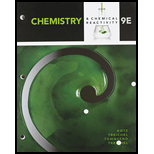
Concept explainers
(a)
Interpretation: The given reaction equation has to be completed and balanced.
Concept introduction: A chemical equation consists of reactants and products. The two are separated by an arrow. Each substances of reactants and products are separated from other by a plus sign. The reactants lies on left hand side while products lies on right hand side of the reaction.
A balanced chemical equation occurs when the number of atoms in reactant side is equal to the number of atoms in the product side.
(b)
Interpretation: The given reaction equation has to be completed and balanced.
Concept introduction: A chemical equation consists of reactants and products. The two are separated by an arrow. Each substances of reactants and products are separated from other by a plus sign. The reactants lies on left hand side while products lies on right hand side of the reaction.
A balanced chemical equation occurs when the number of atoms in reactant side is equal to the number of atoms in the product side.
(c)
Interpretation: The given reaction equation has to be completed and balanced.
Concept introduction: A chemical equation consists of reactants and products. The two are separated by an arrow. Each substances of reactants and products are separated from other by a plus sign. The reactants lies on left hand side while products lies on right hand side of the reaction.
A balanced chemical equation occurs when the number of atoms in reactant side is equal to the number of atoms in the product side.
(d)
Interpretation: The given reaction equation has to be completed and balanced.
Concept introduction: A chemical equation consists of reactants and products. The two are separated by an arrow. Each substances of reactants and products are separated from other by a plus sign. The reactants lies on left hand side while products lies on right hand side of the reaction.
A balanced chemical equation occurs when the number of atoms in reactant side is equal to the number of atoms in the product side.
(e)
Interpretation: The given reaction equation has to be completed and balanced.
Concept introduction: A chemical equation consists of reactants and products. The two are separated by an arrow. Each substances of reactants and products are separated from other by a plus sign. The reactants lies on left hand side while products lies on right hand side of the reaction.
A balanced chemical equation occurs when the number of atoms in reactant side is equal to the number of atoms in the product side.
(f)
Interpretation: The given reaction equation has to be completed and balanced.
Concept introduction: A chemical equation consists of reactants and products. The two are separated by an arrow. Each substances of reactants and products are separated from other by a plus sign. The reactants lies on left hand side while products lies on right hand side of the reaction.
A balanced chemical equation occurs when the number of atoms in reactant side is equal to the number of atoms in the product side.
(g)
Interpretation: The given reaction equation has to be completed and balanced.
Concept introduction: A chemical equation consists of reactants and products. The two are separated by an arrow. Each substances of reactants and products are separated from other by a plus sign. The reactants lies on left hand side while products lies on right hand side of the reaction.
A balanced chemical equation occurs when the number of atoms in reactant side is equal to the number of atoms in the product side.
Want to see the full answer?
Check out a sample textbook solution
Chapter 21 Solutions
Bundle: Chemistry & Chemical Reactivity, Loose-Leaf Version, 9th + OWLv2, 4 terms (24 Months) Printed Access Card
- Why are the lanthanoid elements not found in nature in their elemental forms?arrow_forwardWrite balanced equations for the following reactions: a. The decomposition of dinitrogen oxide gas to its elements. b. The combustion of butane gas.arrow_forwardHow do the acidities of aqueous solutions of Tl₂O and Tl₂O₃ compare with each other? Explain.arrow_forward
- Write two balanced chemical equations in which sulfuric acid acts as an oxidizing agent.arrow_forwardWrite the reaction quotient, Qc, for each of the following reactions:(a) The first step in nitric acid production, NH3(g) + O2(g) ⇌ NO(g) + H2O(g)(b) The disproportionation of nitrogen monoxide, NO(g) ⇌ N2O(g) + NO2(g)arrow_forwardLithium forms several useful organolithium compounds.Calculate the mass percent of Li in the following:(a) Lithium stearate (C₁₇H₃₅COOLi), a water-resistant grease used in cars because it does not harden at cold temperatures(b) Butyllithium (LiC₄ H₉), a reagent in organic synthesesarrow_forward
 Chemistry by OpenStax (2015-05-04)ChemistryISBN:9781938168390Author:Klaus Theopold, Richard H Langley, Paul Flowers, William R. Robinson, Mark BlaserPublisher:OpenStax
Chemistry by OpenStax (2015-05-04)ChemistryISBN:9781938168390Author:Klaus Theopold, Richard H Langley, Paul Flowers, William R. Robinson, Mark BlaserPublisher:OpenStax Chemistry: The Molecular ScienceChemistryISBN:9781285199047Author:John W. Moore, Conrad L. StanitskiPublisher:Cengage Learning
Chemistry: The Molecular ScienceChemistryISBN:9781285199047Author:John W. Moore, Conrad L. StanitskiPublisher:Cengage Learning

